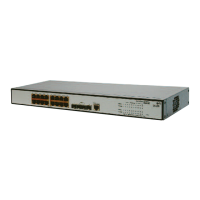1-12
vlan vlan-id: Displays the local users belonging to a specified VLAN. Here, vlan-id ranges from 1 to
4094.
service-type: Displays the local users of a specified type. You can specify one of the following user
types: ftp, lan-access (generally, this type of users are Ethernet access users, for example, 802.1x
users), ssh, telnet, and terminal (this type of user is a terminal user who logs into the switch through
the Console port).
state { active | block }: Displays the local users in a specified state. Here active represents the users
allowed to request network services, and block represents the users inhibited from requesting network
services.
user-name user-name: Displays the local user with a specified username. Here, user-name is a string
of up to 184 characters.
Description
Use the display local-user command to display information about specified or all local users.
Related commands: local-user.
Examples
# Display information about all local users.
<Sysname> display local-user
0 The contents of local user test:
State: Active ServiceType Mask: L
Idle-cut: Enable Idle TimeOut: 3600 seconds
Access-limit: Enable Current AccessNum: 1
Max AccessNum: 1024
Bind location: 127.0.0.1/1/0/2 (NAS/UNITID/SUBSLOT/PORT)
Vlan ID: 1
Authorization VLAN: 2
IP address: 192.168.0.108
MAC address: 000d-88f6-44c1
Total 1 local user(s) Matched, 1 listed.
ServiceType Mask Meaning: C--Terminal F--FTP L--LanAccess S--SSH T--Telnet
Table 1-3 describes the fields in the above display output.
Table 1-3 Description on the fields of the display local-user command
Field Description
State Status of the local user

